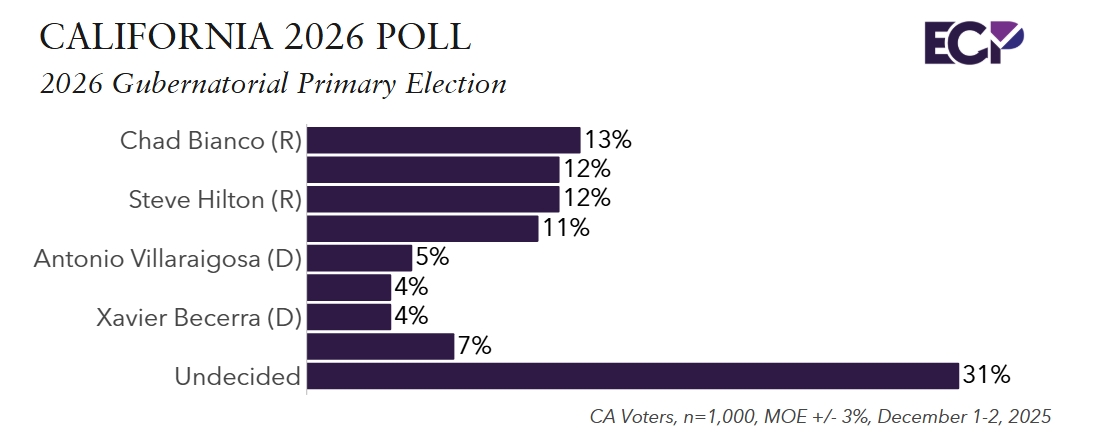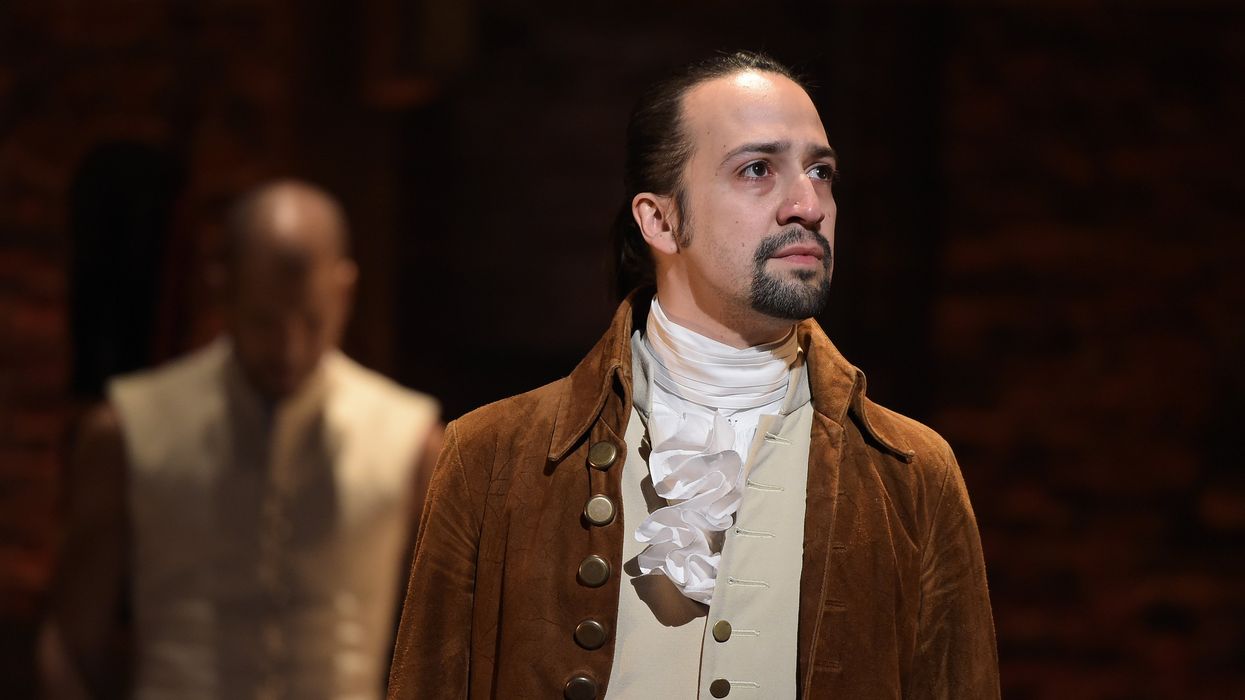OneVirginia2021 is a non-partisan leader in advocating for fair redistricting in Virginia. We organize through local, regional, and statewide efforts and we need your support and participation. OneVirginia2021 partners with individuals and organizations to raise awareness and works with legislators to implement meaningful reform.
Site Navigation
Search
Latest Stories
Start your day right!
Get latest updates and insights delivered to your inbox.
Top Stories
Latest news
Read More
California’s Governor Race Is a Democratic Nightmare, But There’s One Easy Fix
Dec 19, 2025
A new Emerson College poll of California’s 2026 governor’s race confirms what many election observers have suspected. California is entering a high stakes primary season with no clear front runners, a crowded field, and an election system where the outcome often depends less on voter preference and more on mathematical luck.

And before anyone rushes to blame the nonpartisan primary, it is worth remembering that closed primaries produce even fewer Democratic outcomes. Closed primaries exclude independent voters, reduce participation, empower hardened partisans, and guarantee that November voters are stuck choosing between nominees they never had a meaningful chance to support.
California’s nonpartisan system was designed to improve on that. The problem with the top-two system, particularly with a large field, is that the math breaks down in ways voters rarely see.
But 2026 might expose the need for a fix.
Under California’s rules, who advances to November is often determined not by who voters like the most, but based on who else happens to file and get into the competition. Yes, candidates must raise money and build coalitions. But once enough candidates enter the race, the decisive variable becomes something they can’t control: each other.
A random Republican “John Smith,” for example, is almost guaranteed to advance if no other Republican runs. But add one more GOP contender, even a weaker one, and the vote splits in ways that could knock both out. On the Democratic side, the dynamic becomes even stranger.
If dozens of Democrats file, mainstream candidates divide the majority vote across many similar choices, while a fringe candidate with a small but concentrated base can jump into the top tier simply because their voters don’t split.
This isn’t voter driven competition, its math. And it could create a Democratic nightmare.
Scenario One: Two Republicans Advance in a Deep-Blue State
If several Democratic candidates split their own coalition into small slices while one or two Republicans consolidate theirs, a blue state can easily end up with two Republicans on the November ballot. It has happened before under California’s rules and can happen again, especially when large fields dilute competitive lanes.
Scenario Two: Democrats Advance That Most Democrats Didn’t Support
Even if Republicans fail to place a candidate in the top two, Democratic voters could still be stuck with nominees who only captured a small fraction of primary support. In a crowded field, it’s entirely possible for finalists to advance with backing from well under 20 percent of voters. That leaves the broader electorate with choices they never made and never endorsed.
Scenario Three: A Celebrity Candidate Breaks the System
California has a long track record of elevating celebrity figures into political contention practically overnight. Under a top two system, a recognizable outsider only needs 15 to 20 percent of the vote to outpace a field of experienced candidates who divide the remaining support among themselves. We’ve seen this dynamic in California. We’ve seen it nationally. A system built on plurality advancement practically invites it.
The Pattern Is Familiar, and Other States Have Responded
California is not the only state that has run into these structural failures. Alaska moved to a top four system, giving voters a broader and more representative general election field. Local efforts such as More Choice San Diego are pushing for a top five structure, and early polling shows support hovering around 70 percent.
Voters understand the core principle: broader choice in November leads to stronger legitimacy and better outcomes.
Independent Voter Project has been advocating this reform for years, alongside a national coalition of nonpartisan organizations committed to giving independent minded voters a meaningful voice in elections.
And the data we gather from statewide engagement confirms something consistent: when voters are given more options, they participate more, pay more attention, and feel better represented by the process.
Here’s the Easy Fix: Advance 5 Candidates to the General
California doesn’t have to overhaul its entire election system. It simply has to finish the job it started when it adopted the nonpartisan primary. Instead of advancing two candidates to November, advance five.
A top five general election and let voters rank them:
- Prevents two Republicans from advancing in a blue state.
- Prevents Democrats from being stuck with nominees they never supported.
- Prevents a celebrity from hijacking the ballot with a fractured primary plurality.
- Gives November voters a field that actually reflects their preferences.
- Aligns California with modern nonpartisan reform models already succeeding elsewhere.
- Retains the virtue of Top Two because no one gets elected in November without a majority of voter support.
California’s current system forces too many voters to choose between too few options they never selected. Expanding the November ballot to five finalists gives voters what the system was supposed to deliver in the first place: more choice, more legitimacy, and outcomes that reflect the will of the full electorate.
The nightmare scenarios are all possible. The fix is simple. And California already has the blueprint to get it done.
California’s Governor Race Is a Democratic Nightmare, But There’s One Easy Fix was originally published by Independent Voters News and is republished with permission.
Keep ReadingShow less
Recommended

When ego replaces accountability in the presidency, democracy weakens. An analysis of how unchecked leadership erodes trust, institutions, and the rule of law.
Brandon Bell/Getty Images
When Leaders Put Ego Above Accountability—Democracy At Risk
Dec 18, 2025
What has become of America’s presidency? Once a symbol of dignity and public service, the office now appears chaotic, ego‑driven, and consumed by spectacle over substance. When personal ambition replaces accountability, the consequences extend far beyond politics — they erode trust, weaken institutions, and threaten democracy itself.
When leaders place ego above accountability, democracy falters. Weak leaders seek to appear powerful. Strong leaders accept responsibility.
Americans want leaders who embody honesty, humility, and respect — values we teach our children. When leaders abandon these qualities, the nation’s character suffers.
The president’s public behavior is defined by bullying and humiliation — mocking governors as “fat” or “ugly,” calling citizens “pigs,” and ridiculing reporters on live television. These are not displays of strength but symptoms of insecurity. Research shows ethical leaders demonstrate humility and accountability, not cruelty (Frontiers in Psychology).
The pandemic revealed the cost of ego. In October 2020, when hospitalized with COVID‑19, the president staged a balcony moment by removing his mask after leaving Walter Reed (BBC). What could have modeled humility became a performance of ego instead.
Ego unchecked is most dangerous in matters of war and peace. Leaders who bypass Congress or claim unilateral authority erode constitutional balance (Congressional Research Service). Oversight is not an obstacle; it is a safeguard.
A healthy ego gives courage. An inflated ego breeds arrogance, stifles collaboration, and destroys accountability. True accountability requires humility and the willingness to admit mistakes. Instead, ego‑driven leaders pursue personal ambition — as seen in legislation like the Big Beautiful Bill or the reversal of Roe v. Wade (NPR Illinois), both ignoring the voices of millions.
These actions reveal a deeper problem: when presidents face no effective checks, they learn to exploit gaps in accountability. Long before he came to the White House, Trump had already mastered the art of loopholes — in business, in taxes, and in government. He bragged about finding ways around rules, and each time institutions failed to enforce boundaries, his ego grew stronger, and his disregard for responsibility deepened.
Trump is a master of loopholes. In the past, he has bragged about it. He entered the White House with an already inflated ego and the practiced skill of exploiting gaps in accountability. He has never apologized or taken responsibility — he sues and moves on. If citizens could sue him directly, he would drown in lawsuits.
Ego is not confined to the presidency. Members of Congress who evade accountability and justices who fail to uphold their oaths also reveal how inflated egos corrode trust. When legislators place loyalty above courage, or when judges prioritize ideology over integrity, democracy suffers. This is not a partisan problem — it is a bipartisan failure of character.
The consequences of loopholes are not abstract. In a dialysis center, patients and nurses feel the weight of policies shaped by ego and neglect. When leaders exploit gaps in accountability, the result is cuts to care, understaffed facilities, and exhausted professionals. Citizens see firsthand that when ego drives decisions, it is their health, dignity, and trust that suffer.
History reminds us that unchecked leaders rarely stop at one abuse of power. When accountability is absent, ego expands. Past presidents who evaded responsibility left scars on the nation, proving that democracy cannot survive without boundaries.
Chaotic governance is not just embarrassing; it is dangerous. Spectacle displaces stewardship, and ego replaces service. Fiscal spectacle had consequences, with record deficits documented by ConsumerAffairs and the Peter G. Peterson Foundation. These numbers reflect chaos rather than disciplined governance.
The damage extends beyond budgets. Ego corrodes institutions, dampens morale, and erodes trust. Staff and advisors navigate a hostile environment where flattery is demanded and honesty punished. Citizens disengage, exhausted by insults and spectacle.
Accountability requires courage from those closest to power. Cabinet members must stop offering fake praise simply to inflate the president’s ego. He nominated a cabinet for loyalty, not competence — a chorus of enablers feeding his insecurity. Weak leaders demand applause; strong leaders accept responsibility. Cabinet officials must replace flattery with honesty and confront ego rather than enable it.
We have observed citizens switching the television channel when governance becomes a spectacle of insults. This disengagement is not apathy; it is a reaction to chaos that undermines trust. The spectacle of insults is well documented, with dozens of personal attacks directed at officials, citizens, and reporters.
Americans want leaders with a healthy ego — one grounded in confidence, humility, and service. A healthy ego empowers others, listens to experts, and accepts responsibility. An unhealthy ego demands applause, silences dissent, and rewards flattery.
Finding solutions will not be easy. It will take persistence, courage, and vigilance because the president has rarely been checked. Ego, this inflated, resists boundaries. However, Congress is not powerless. Through its power of the purse, it can curb reckless spending. Through hearings and subpoenas, it can expose misconduct. And through its confirmation authority, the Senate can demand integrity in appointments. Oversight is not obstruction; it is the safeguard of democracy.
The Supreme Court must also act. Judicial review is not obstruction; it is a safeguard against ego‑driven overreach. The Court can revisit or overturn immunity doctrines that shield presidents from accountability. By reaffirming that no leader is above the law, the Court can restore balance and protect the integrity of our democracy.
The call is clear: Citizens must reclaim democracy. Your voice, your vote, your vigilance — these are the tools we must employ to restore integrity to leadership and help the president check his own ego. Accountability is not punishment; it is patriotism. Integrity is not optional; it is the cornerstone of a free society.
And citizens must go further: demand that your senators and representatives at the local, state, and national levels hold the president accountable. Democracy cannot survive if elected officials remain silent or complicit.
The presidency is not a stage for ego. It is a trust, sworn by oath, to serve the people. When leaders abandon accountability, they abandon democracy itself. Democracy will survive only if citizens persist, demand courage, enforce accountability, and refuse to be silenced.
Carolyn Goode is a retired educational leader and advocate for ethical leadership and government accountability.Keep ReadingShow less

A Pentagon watchdog confirms senior officials shared sensitive military plans on Signal, risking U.S. troops. A veteran argues accountability is long overdue.
Jonathan Raa/NurPhoto via Getty Images
There’s No Excuse for Signalgate
Dec 18, 2025
The Defense Department Inspector General just announced that information shared by Defense Secretary Hegseth in a Signal chat this spring could have indeed put U.S. troops, their mission, and national security in great peril. To recap, in an unforced error, our Defense Secretary, National Security Advisor, and Vice President conducted detailed discussions about an imminent military operation against Houthi targets in Yemen over Signal, a hackable commercial messaging app (that also does not comply with public record laws). These “professionals” accidentally added a journalist to the group chat, which meant the Editor-in-Chief of the Atlantic received real-time intelligence about a pending U.S. military strike, including exactly when bombs would begin falling on Yemeni targets. Had Houthi militants gotten their hands on this information, it would have been enough to help them better defend their positions if not actively shoot down the American pilots. This was a catastrophic breakdown in the most basic protocols governing sensitive information and technology. Nine months later, are we any safer?
As a veteran, I take their cavalier attitude towards national security personally. I got out of the Navy as a Lieutenant Commander after ten years as an aviator, a role that required survival, evasion, resistance, and escape training before ever deploying, in case I should ever get shot down. To think that the Defense Secretary, National Security Advisor, and Vice President could have so carelessly put these pilots in danger betrays the trust troops place in their Chain of Command while putting their lives on the line in the service of this country.
During my service, I held additional roles as the Command Legal Officer and Security Manager. So, when someone accidentally printed the word SECRET on a document that wasn’t actually classified, the issue fell squarely on my desk. There was no leak of any information whatsoever, but the inadvertent mislabeling was enough to trigger a crisis that involved filing reports, conducting an investigation, and giving command-wide training. By contrast, the Administration reduced Signalgate to “an inadvertent number added to the chain" and also a "demonstration of deep and thoughtful policy coordination between senior officials.”
Back in March, I asked my chain of command: “We’d immediately get fired if we had done this, right?”
They said: “We’d go to prison.”
Instead, Hegseth kept his job and is now being scrutinized for authorizing what could range from war crimes to outright murder in the Caribbean Sea. These Signalgate texters were unforgivably reckless with the safety of American troops; out of concern for national security (and out of respect for our servicemembers), shouldn’t they all have been fired —or imprisoned—back in March?
It is inexcusable that such avoidable actions could have resulted in American lives lost. It is also a problem, however, that it took nine months to officially identify this as the colossal cybersecurity blunder it is. As Americans, we deserve leaders who aren’t cavalierly texting military plans over messaging apps, and we deserve leaders who hold them accountable.
Perhaps this incident and the fallout (or lack thereof) are revealing of how illiterate many of our leaders are when it comes to the risks posed by technology. When the median age of a U.S. Senator is almost 65 years old, and our own president admits he has barely used any form of digital communication—email, text, etc.—since 2010, could it be that many of our leaders in the federal government are simply not tech-savvy enough to have made sense of this breach? Congress has yet to pass any meaningful legislation around regulating AI–are our leaders just Luddites?
If we do give them the benefit of the doubt–that if they only had understood the immense risk to national security that using an app like this posed, they would have demanded immediate accountability—then moving forward, we must elect leaders who do understand. From the General Data Protection Regulation (GDPR) to the Cyber Resilience Act, Europe has implemented robust legislative frameworks to ensure digital security and accountability. Whatever interest has kept American lawmakers from passing similar protections can’t possibly be more compelling than the safety of American lives.
Next election cycle, vote for candidates who know the risks associated with technology and have the integrity to write policy to mitigate those risks, follow protocols already in place, and prosecute those who do not. In the meantime, we need 21st-century policies that can properly respond to these systemic failures of both security and accountability. We must demand that Congress enact mandated communication protocols for all senior Executive Branch officials with legally codified penalties. When senior officials mishandle sensitive information, the consequences should be uniform and automatic, not discretionary, and certainly not decided by political appointees.
How we use technology affects national security. Leaders playing fast and loose with either g2g.
Julie Roland was a Naval Officer for ten years, deploying to both the South China Sea and the Persian Gulf as a helicopter pilot before separating in June 2025 as a Lieutenant Commander. She has a law degree from the University of San Diego, a Master of Laws from Columbia University, and is a member of the Truman National Security Project.
Keep ReadingShow less

a wooden gaven sitting on top of a white counter
Photo by Wesley Tingey on Unsplash
Ex‑Chief Justices Unite to Defend Judicial Independence
Dec 18, 2025
On Tuesday, Bill of Rights Day, Keep Our Republic (KOR), a nonpartisan civic education organization committed to preserving American democracy, announces the launch of the Alliance of Former Chief Justices—a nonpartisan initiative committed to educating the public about the role of the judiciary and safeguarding the constitutional balance envisioned by the Founders.
Keep Our Republic’s Alliance of Former Chief Justices will lead a broad public-education effort, working with civic organizations, the media, educational institutions, policymakers, and the legal community to explain how courts function and why they matter. This outreach will highlight the constitutional role of courts, the importance of judicial independence, judges’ duty to apply the law impartially, and how the separation of powers protects Americans’ fundamental freedoms.
“Trust in our institutions is declining, and that is especially dangerous for the judiciary, which depends on public confidence to ensure that its decisions are accepted and obeyed,” said Thomas Phillips, former Chief Justice of the Texas Supreme Court. “It is important for Americans to remember that judges are very different from elected officials: they apply the law, not politics. As former chief justices, we can speak freely about why that distinction matters and why an independent judiciary is essential to our democracy.”
Bill of Rights Day marks the ratification of the first ten amendments—protections that rely on courts capable of applying the law fairly and free from political pressure. The justices note that this day is a fitting moment to launch an effort to reinforce the rule of law and public trust in the judiciary.
“As a lawyer for over 50 years and a former Chief Justice and Justice of the Florida Supreme Court, I am deeply concerned over partisan attacks on judges and attempts to undermine the rule of law,” said Barbara Pariente, former Chief Justice of the Florida Supreme Court.” Our country was founded on the deeply important principle of three equal branches of government and checks and balances. At present, those principles are being undermined in a highly partisan and political way. Sitting judges and justices, both in the state and federal courts, cannot speak out for themselves. It is important that those of us who are retired justices and chief justices use our voices to speak out for them.”
Keep Our Republic’s Alliance of Former Chief Justices will lead a broad public-education effort, working with civic organizations, the media, educational institutions, policymakers, and the legal community to explain how courts function and why they matter. This outreach will highlight the constitutional role of courts, the importance of judicial independence, judges’ duty to apply the law impartially, and how the separation of powers protects Americans’ fundamental freedoms.
“I am joining this educational effort because we are at a moment when the principles of our democracy and the rule of law face stresses unlike any I have seen in my lifetime,” said Dan Wathen, former Chief Justice of the Maine Supreme Court. “It is critically important that everyone understands what is at stake in safeguarding our constitutional system built on the separation of powers, an independent judiciary, and equal justice under law."
The launch comes at a time when judges across the nation face heightened political pressure and public attacks aimed at influencing outcomes or casting the judiciary as partisan. The justices caution that while debate over decisions is healthy civic engagement, portraying judges as “politicians in robes” undermines equal justice and weakens the constitutional safeguards that protect all Americans.
“We are facing unprecedented challenges to the rule of law. Former state chief justices have a unique perspective on the critical role of the judiciary in our democracy,” said Mark E. Recktenwald, former Chief Justice of the Hawaii Supreme Court. “We each led court systems that, in total, deliver equal justice to millions of people each year. Those courts make decisions based on the law and facts of each case, regardless of the power or popularity of the parties. We need to explain to the public that our judicial system has integrity and is worthy of the trust and confidence of the American people. That’s why I strongly support the Alliance of Former Chief Justices.”
In their founding statement, the justices underscore that the U.S. and state constitutions divide governmental power among three branches to prevent the concentration of authority—what James Madison called “the very definition of tyranny.” Judges, they emphasize, differ from elected officials because they serve only one constituent: the rule of law.
“I have been a public servant most of my professional life, and the maintenance of democratic institutions is a critical part of my mission. Public servants, by raised voice and action, must help the public reaffirm their trust in their government. To that end, each branch of government must be accountable to the people,” said Conrad Mallett, former Chief Justice of the Michigan Supreme Court. “Every day, the judiciary acts as a check on the other two branches, and the public’s awareness that independent jurists—unconnected to the parties and focused solely on answering the questions presented—is essential to maintaining trust in their government.”
This article was written in part from a press release by KOR.
Keep ReadingShow less
Load More
















